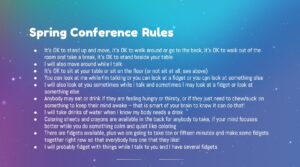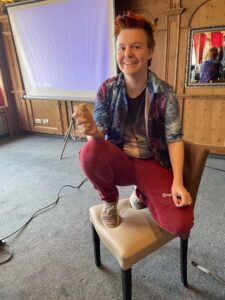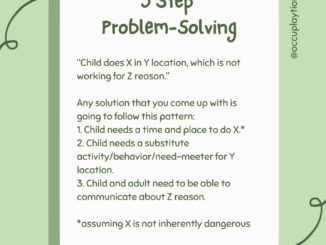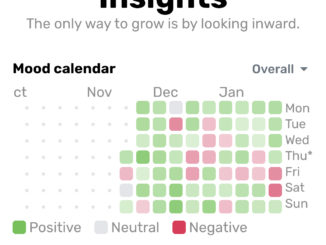My conference this week was absolutely amazing. I have a million thoughts rattling in my head and they need some time to condense into ways to explain myself, to share with you about what I learned, what I was able to share, what all this week meant to me.
I’m going to share this, though (and then I’ll end up talking about it even more in depth, in days to come). What I wanted most, more than anything, out of this conference, was for me to make the learning accessible to the attendees, in a way that would mirror the way that I wish learning was made accessible for the children I work with.
However, I was faced with the challenge of knowing that it wasn’t as simple as giving the group of adults the exact same things that I would give a group of children and assuming that their take away from it would be everything I wanted it to be. After all, a group of 25 professional adults inherently has fewer movement needs than a group of 25 six-year-olds…a group of 25 people who have paid to be at a conference that happens for two days out of the year have different learning expectations than a group of 25 people who are being required to be in a room every day for their entire known life…and so on. So I knew I couldn’t just make it exactly, one-to-one, like I would make a learning opportunity for kids. But I wanted to somehow capture the HEART of it, of what I wish was available for kids, and give that same heart and those same wishes and that same consideration to the adults.
The first and foremost way that I did that was by modeling with my own body, and by being specific and descriptive with my words about how I would be modeling it with my own body and what that meant I expected of everybody else. Because this is how I would do it with kids.
If nobody else in the conference took a single, one single thing away from what I said — I think this hit the nail on the head a million percent like I wanted it to. This language up front, this modeling with my own body.
(I also knew that my body would not be able to speak for 6 hours a day, 2 days in a row, if I had to pretend, mask, or be doing a “performance” with my body the whole time. So I also was upfront honest and earnest about my needs because I needed that in order to be able to function well and share my best thoughts and ideas…and that resonated really hard with everybody, too.)

I shared these “Spring Conference Rules” with the group really early on. It reads:
- It’s OK to stand up and move, it’s OK to walk around or go to the back, it’s OK to walk out of the room and take a break, it’s OK to stand beside your table
- I will also move around while I talk
- It’s OK to sit at your table or sit on the floor (or not sit at all, see above)
- You can look at me while I’m talking or you can look at a fidget or you can look at something else
- I will also look at you sometimes while I talk and sometimes I may look at a fidget or look at something else
- Anybody may eat or drink if they are feeling hungry or thirsty, or if they just need to chew/suck on something to keep their mind awake – that is smart of your brain to know it can do that!
- I will take drinks of water when I know my body needs a drink
- Coloring sheets and crayons are available in the back for anybody to take, if your mind focuses better while you do something calm and quiet like coloring
- There are fidgets available, plus we are going to take ten or fifteen minutes and make some fidgets together right now so that everybody has one that they like!
- I will probably fidget with things while I talk to you and I have several fidgets
There was a little bit of laughter as I shared these “rules”, as they popped up on the screen one at a time, but then I pointed to the table of fidgets and coloring sheets that I’d brought and then we promptly spent 15 minutes making fidgets together and talking before the conference even began, so everybody truly got that I meant what I said.
And then the first person felt empowered to get up from their seat and pace around at the side when they needed to, and then EVERYBODY could do it. Some people sat in their seats almost the whole time. Some people sat on the floor. Some people did stretches against the wall. Some people leaned standing against the wall. Some people alternated between when they sat and when they stood.
I spent most of my time not looking at people’s faces or eyes, but looking out the window, at the ceiling, at the back of the room (past everybody), or at my screen to help me out with visual aids.
I held at least one fidget almost the entire time: my poky spiky ring fidget, a small squishmallow (actually a happy meal toy) that I love to squeeze and pet, and my homemade one with a pipe cleaner and beads were my favorites.
I also alternated between when I sat and when I stood. By the end of it I was actually perching on the chair sometimes — I took notice of myself suddenly and realized I was perching with both my feet on the chair, holding a fidget in each hand, and I had my friend take a (staged) picture of me afterward in that position because I thought how unusual it is to see in a professional context, how perfectly it encapsulated this entire conference, this entire experience, what I hoped above all else to be able to impart.

I’ll talk more in depth about all of this and revisit this topic again many times, I’m quite sure, as I dissect this experience and all the things I loved about it to share with you in the week or two to come, but I couldn’t wait to share this bit with you. It was my favorite thing, I think. How much I could be me. How much everybody could be them. How we could all come together to learn how we learned, and nobody had to pretend.



